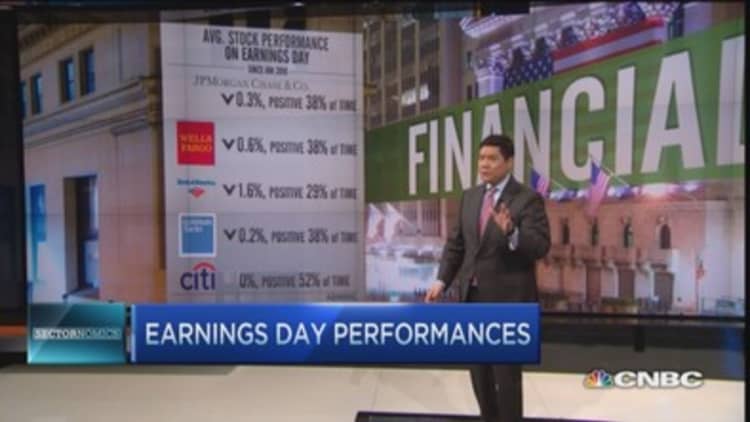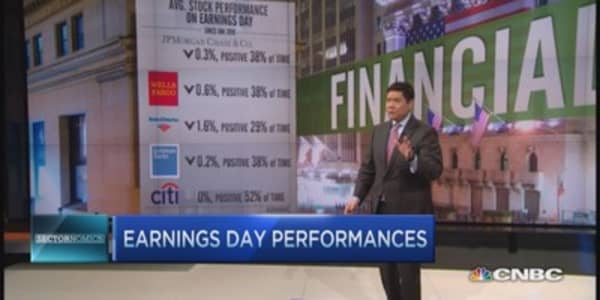


How do bank stocks react to an interest-rate hike? A better question might be: Do you really think there's a simple answer to that question?
Oppenheimer & Co. banking analyst Chris Kotowski conducted an exhaustive analysis of the issue in 2013 and prefaced it by saying, "We believe that the first step in gaining knowledge is always rooted in first being honest with oneself about what you don't and possibly can't know." After rattling off a few examples of seemingly contradictory bank-stock reactions to previous Fed-rate changes, Kotowski stated, "The relationship between bank stocks and rates is anything but straightforward."
This section of the Oppenheimer analyst's report was titled, "Nothing correlates with anything."
Making a call on any one bank stock might be hard to do based on the Fed alone, but there are certain dynamics that apply to bank stocks generally that investors can profit from as the Fed moves, bank analysts said.
Here are 9 keys to moving in, and out, of bank stocks around Fed rate-raising action.
1. Interest-rate changes are the second most important trigger for bank stocks.
Nothing is more important than quality of assets when it comes to bank-stock valuations—anyone who didn't learn that lesson from the financial crisis has been asleep for more than half a decade. But the quality of assets at the banks is considered relatively stable today—there is even talk that banks are overly liquid. Interest rates are the second most important trigger for bank stocks, coming ahead of actual earnings changes, analysts said. That means paying attention to bank stocks as rates rise is a must.
2. Just because bank stocks have already been given credit for a Fed-rate hike doesn't mean they won't be given credit twice.
In response to the argument that bank stocks react strongly to rate hikes, you might say, "Well, that was completely obvious. In fact, isn't that why banks did so well in 2014 and why they've underperformed this year?"
U.S. financials are down 1.5 percent so far in 2015, and the theory is that, among other things, investors got tired of waiting for the Fed to raise rates and decided that the rate hike they had already baked into bank stocks needed to be taken out of the bank stocks' prices. But that also means when the Fed finally does raise rates, bank stocks will have the premium placed right back in and it would make sense to be ahead of that. So even if bank stocks trade down on earnings this quarter, investors should consider if the Fed-rate hike that still hasn't happened will be priced back into bank stocks again.
Read More The best-performing bank stocks this year are far, far away from Wall Street
An old adage on Wall Street is that the news—whatever it may be—is baked in when it's first figured out, and then when it actually occurs. So why wouldn't that apply to bank stocks and rates?
"Theoretically, it should be priced in, but until it's a certainty, it's never priced in, and there's been a lot of false starts to higher rates," said Guy Moszkowski, bank analyst at Autonomous Research.
3. Don't expect quick-fire day-trader profits when or if a rate hike is priced into bank stocks again. A little patience may be required, but it is likely rewarded.
Dick Bove, bank analyst at Rafferty Capital Markets, said that in his experience, bank stocks trade down immediately after a rate hike, but if you look at the overall impact, it's decidedly positive for bank stocks.
Data from CNBC data partner Kensho supports that anecdotal view. In the past three rate-hike cycles, Citigroup and the S&P 500 were negative in the three months after a rate hike (see complete Kensho data below), but the banks and U.S. equities more broadly turned in strong performance in the six-month and one-year period following a rate hike.
If you want to think more like a high-frequency trading machine and throw nuanced market narratives out the window, consider the following analysis from CNBC data partner Kensho on how the big bank stocks have traded into and out of three recent Fed rate-hike cycles (not including 03/25/1997 tightening as it was a one-off event). With it still unclear when exactly the Fed will raise rates in 2015 (if it does), the following trading analysis is relevant.
Readers will note that, at least based on recent rate cycles, the rally in bank stocks after a rate hike has been real but can take some time before it is baked into the bank-stock prices. The caveat (and it's a big one) is that the three recent Fed rate-hike cycles were all previous to the financial crisis and an unprecedented low-rate environment. The other caveat is that bank stocks look nothing today like they looked in previous decades, when they were basically state-regulated players in an era before the mega-merger universal banks were created. So the trading territory is, to use a market pun, uncharted.
Before Fed tightening
3 months before:
Wells Fargo 100% positive; 9.02% average return
S&P 500 100% positive; 3.38% average return
6 months before:
PNC Bank 100% positive; 13.32% average return
Wells Fargo 100% positive; 9.94% average return
S&P 500 100% positive; 8.38% average return
After Fed tightening
3 months after:
Citigroup 0.00% positive; -5.63% average return
S&P 500 0.00% positive; -3.67% average return
6 months after:
Citigroup 100% positive; 10.39% average return
S&P 500 67% positive; 1.78% average return
JP Morgan Chase 33% positive; -4.04% average return
12 months after:
Citigroup 100% positive; 18.06% average return
Wells Fargo 100% positive; 14.29% average return
S&P 500 100% positive; 6.90% average return
4. Getting the timing right on the bank-stock play is critical and having confidence it won't be a one-time event.
Bank analysts agree that if the Fed decides on a "one and done" course with a rate hike, it will not be of consequence to bank stocks—in fact, they could sell off hard if the market is late to that recognition.
"We will need a steady round of increases. If we go up 25 basis points and then pause for a year, it won't be helpful," said Scott Siefert, bank analyst at Sandler O'Neill.
5. So just how many 25-basis-point rate increases will it take?
Four to eight consecutive quarters of rate increases seems to be the bank analyst handicapping estimate.
Kotowski doesn't expect any Fed-related action in bank stocks until later in the year, and the benefit to bank stocks will be gradual as long as the Fed stays the course. "The ideal scenario for banks would be eight quarters of 25-basis-point increases in the Fed funds rate," Kotowksi said. "A nice gentle ramp back to something resembling a normal rate environment."
6. If a Fed-rate hike is a good thing for up to eight quarters, what happens after that?
The answer? All bets are off—so don't keep betting on bank stocks as a rate play.
"My guess is that rates can go up 200 basis points to 300 basis points before bank stocks start to fall," Bove said. "That means the pendulum won't swing back to the negative for four to eight quarters."
Banks' disclosure about their rate-sensitivity position is generally dreadful, perhaps surpassed in opacity and inconsistency only by banks' shamefully inadequate disclosures around trading. The impacts vary, and God only knows how comparable the models and numbers are, but we think it is all favorable.Chris KotowskiOppenheimer & Co. bank analyst
7. A good thing can become a bad thing because of the way bank assets are priced.
Oppenheimer's Kotowski said, "We believe the early phases of the rate cycle will be positive for bank stocks, but the later phases become increasingly risky. We believe that the early phases will be good for bank stocks because they are generally asset-sensitive and also higher rates are driven by a stronger economy and higher loan demand."
His 2013 report noted that "since 1960, there have been six periods of discontinuous rate increases in which short rates on average rose 527 basis points over 35 months. These discontinuous increases significantly elevate risks to banks."
In the short term, as short-term rates rise, banks will be able to benefit through increased net interest margins. But longer term, as longer-term rates also start to rise, the risks to banks include negative impact on their assets: "funding squeezes against long-dated assets, like Jumbo mortgages and MBS; the potential for a 'nuclear winter' in terms of corporate debt issuance; and positioning losses, either in direct trading portfolios or customer portfolios that may be funded with margin debt," Oppenheimer concluded.
8. There is no best bank stock. They are all rate sensitive, but the only thing they are equal at when it comes to rate sensitivity is how much their disclosure about it leaves much to be desired.
Banks have publicly disclosed the fact that they expect a Fed rate hike to be beneficial—they have to. In their annual reports, they rate their asset sensitivity to rate hikes. Bank managements expect a boost to net interest income from the first 100-basis-point increase in rates, according to Oppenheimer's analysis of the bank disclosures. Bank of America, for example, said in its most recent 10-K that if there were a 100-basis-points increase in rates, it would expect an additional $3.7 billion in net interest income in 2014.
JPMorgan Chase estimated $2.8 billion in additional interest income for a 100-basis-point change; more than $4.6 billion for a 200-basis-point increase.
Citigroup put the same estimate at a little over $1 billion—having a lot of assets held overseas is part of the reason its estimate is much lower, Bove said. (Citigroup estimated an additional $629 million in net interest income gains in other currencies.)
Read MoreThe next big Apple blowout surprise could be its dividend
Should you trust the banks on their net interest income? Yes and no, analysts say.
Kotowski wrote, "Banks' disclosure about their rate sensitivity position is generally dreadful, perhaps surpassed in opacity and inconsistency only by banks' shamefully inadequate disclosures around trading." But he concluded, "The impacts vary, and God only knows how comparable the models and numbers are, but we think it is all favorable."
Moszkowski said his research found two-thirds of the banks tend to be right about the impact of rates on their assets, though the order of magnitude never seems to be what they thought.
9. The bank's business mix makes a big difference.
Sandler O'Neill's Siefert said for the regional banks he covers, other than M&A that can't be foreseen, it's the biggest catalyst out there. He said loan growth rates are normal again and the mortgage market has mostly played itself out. Meanwhile, the banks have done what they can on the cost side of the equation. "The rate play is all that's left."
Kotowski said based on his analysis, Bank of America and PNC are the most rate sensitive among the big banks, but the real story is that all the banks are on a boat sailing in the same direction.
The tide will rise for bank stocks again, analysts concluded, when the Fed actually does something.





